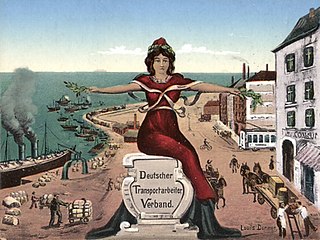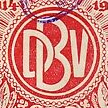In British politics, an affiliated trade union is one that is linked to the Labour Party. The party was created by the trade unions and socialist societies in 1900 as the Labour Representation Committee and the unions have retained close institutional links with it.
The General German Trade Union Federation was a confederation of German trade unions in Germany founded during the Weimar Republic. It was founded in 1919 and was initially powerful enough to organize a general strike in 1920 against a right-wing coup d'état. After the 1929 Wall Street crash, the ensuing global financial crisis caused widespread unemployment. The ADGB suffered a dramatic loss of membership, both from unemployment and political squabbles. By the time the Nazis seized control of the government, the ADGB's leadership had distanced itself from the Social Democratic Party of Germany (SPD) and was openly cooperating with Nazis in an attempt to keep the organization alive. Nonetheless, on May 2, 1933, the SA and SS stormed the offices of the ADGB and its member trade unions, seized their assets and arrested their leaders, crushing the organization.
The General Commission of German Trade Unions was an umbrella body for German trade unions during the German Empire, from the end of the Anti-Socialist Laws in 1890 up to 1919. In 1919, a successor organisation was named the Allgemeiner Deutscher Gewerkschaftsbund, and then in 1949, the current Deutscher Gewerkschaftsbund was formed.
The Construction Trade Union is a trade union representing workers in the construction industry in Finland.

The German Union of Building Trades was a trade union representing construction workers in Germany.

The German Transport Workers' Union was a trade union representing transport workers in Germany.
The German Tobacco Workers' Union was a trade union representing people in the tobacco manufacturing industry in Germany.

The German Wood Workers' Union was a trade union representing carpenters, joiners, and related workers, in Germany.
Central Union of Roofers was a trade union representing roofers in Germany.
The German Leather Workers' Union was a trade union representing workers involved in tanning and glovemaking.
The Central Union of Bakers and Confectioners was a trade union that played a significant role in representing workers in bakeries and related trades in Germany.
The Union of Brewery and Mill Workers and Kindred Trades was a trade union representing workers in the food and drink processing industry in Germany.
The Central Union of Butchers and Kindred Trades of Germany was a trade union representing butchers and abattoir workers in Germany.

The German Furriers' Union was a trade union representing fur workers in Germany.
The Union of Saddlers and Portfolio Makers was a trade union representing workers involved in making saddles, bags and wallets.
The Union of German Restaurant Workers was a trade union representing workers in hotels and restaurants in Germany.
The Central Union of Masons was a trade union representing bricklayers in Germany.
The Central Union of Construction Workers was a trade union representing building labourers in Germany.
The Central Union of Potters was a trade union representing pottery workers in Germany.

The General Dutch Construction Union was a trade union representing workers in the construction industry in the Netherlands.





